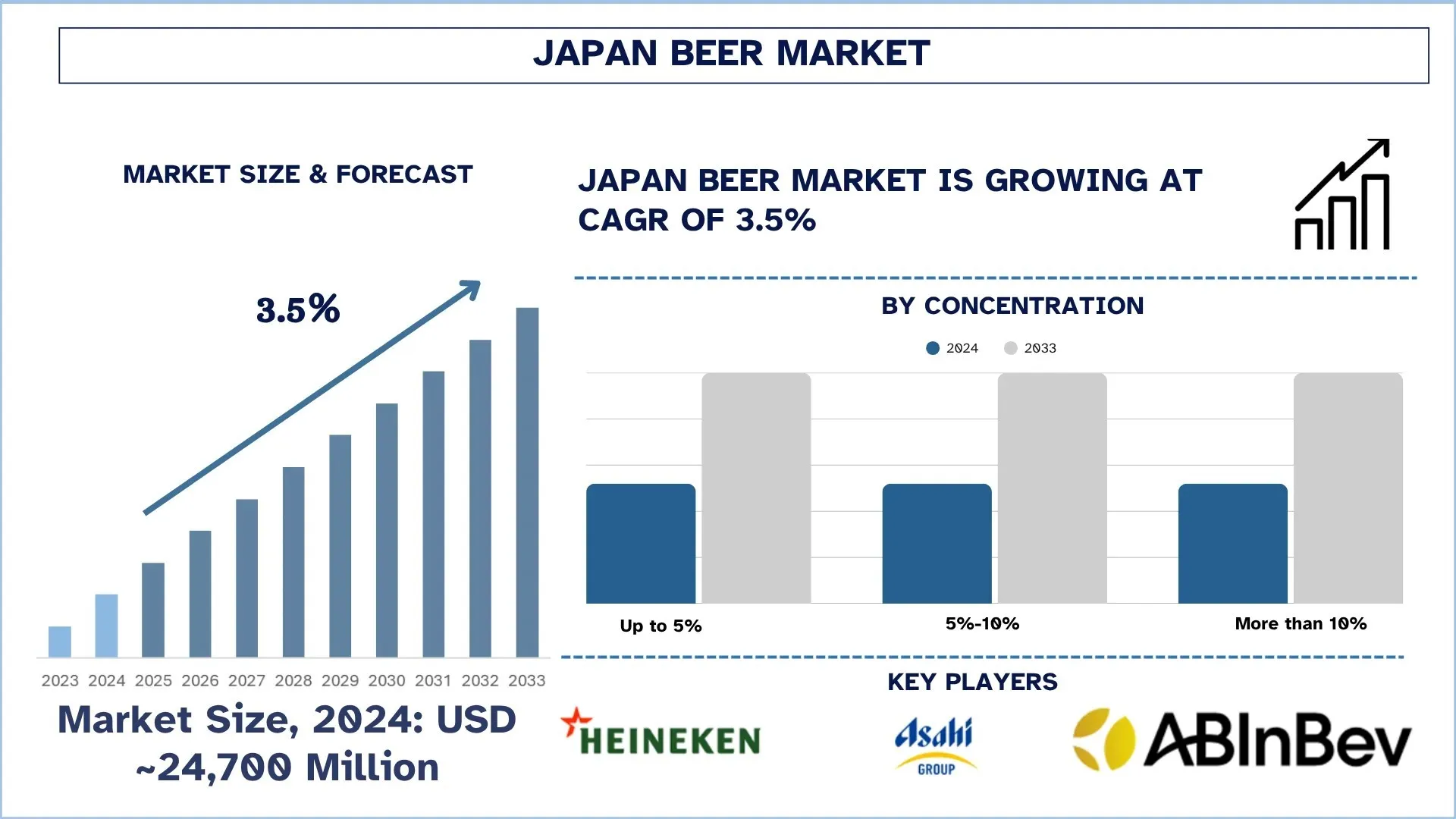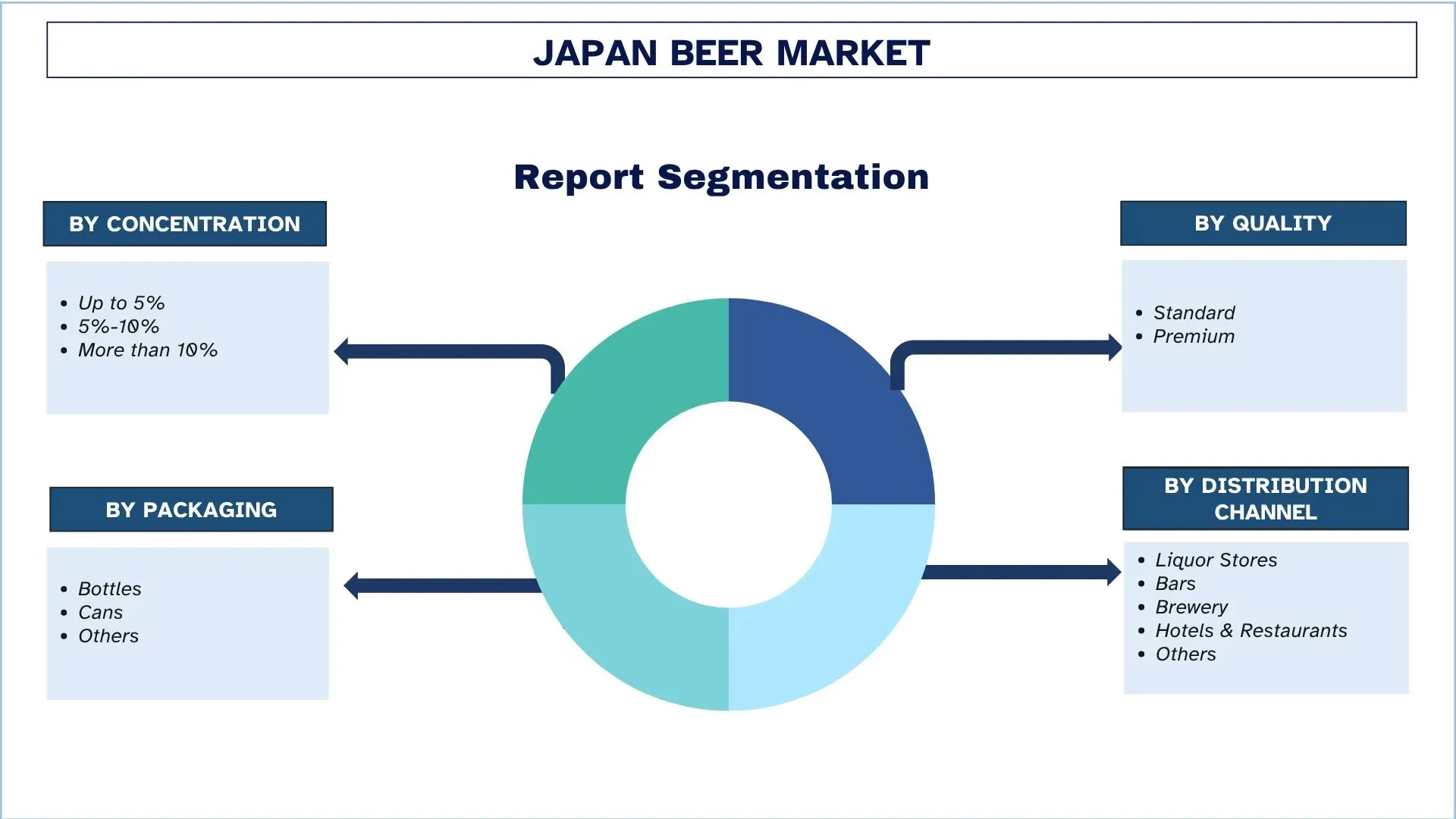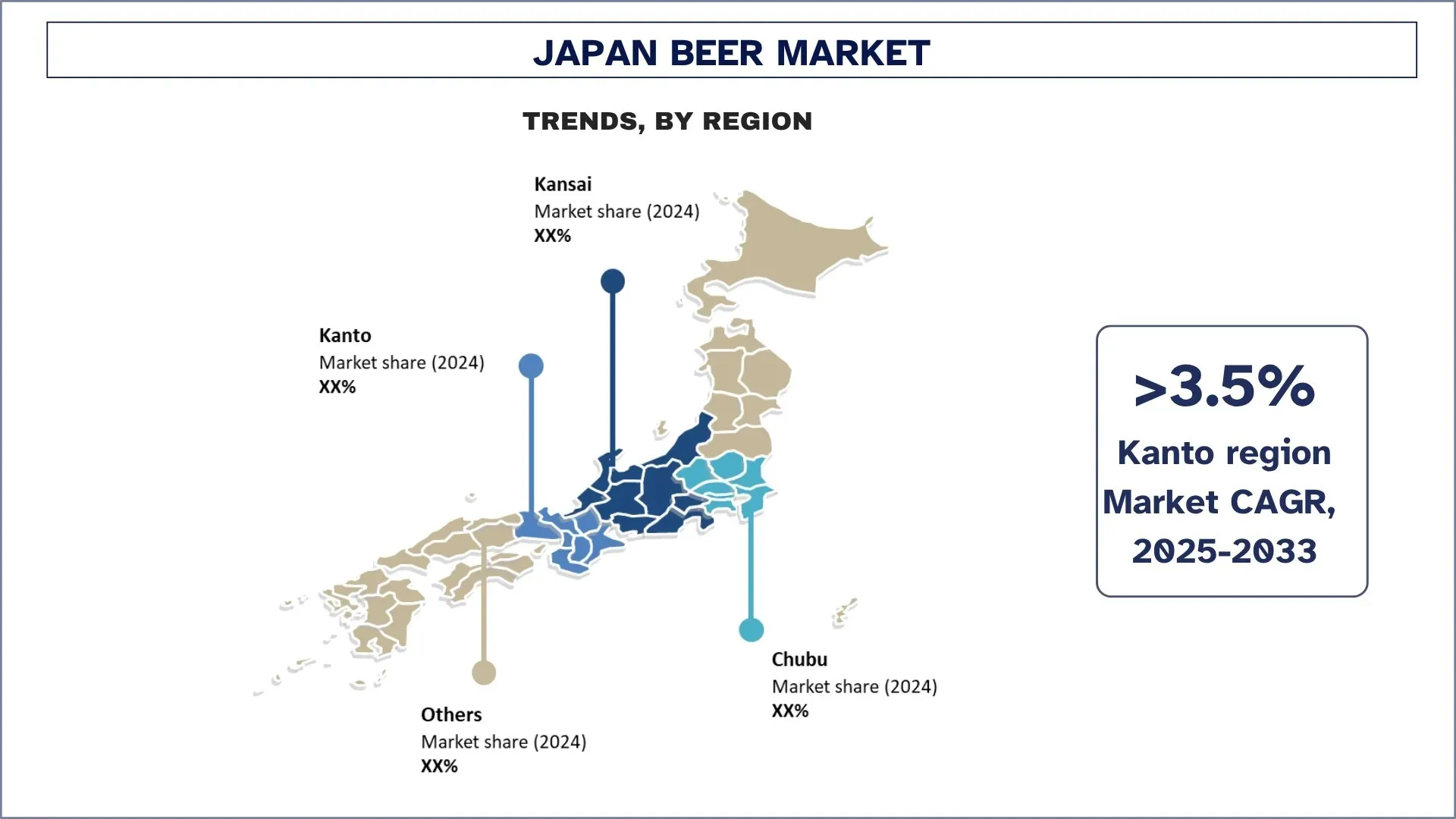- Home
- About Us
- Industry
- Services
- Reading
- Contact Us
Japan Beer Market: Current Analysis and Forecast (2025-2033)
Emphasis By Concentration (Up to 5%, 5%-10%, More than 10%), By Quality (Standard, Premium), by Packaging (Bottles, Cans, Others), By Distribution Channel ( Liquor Stores, Bars, Brewery, Hotels & Restaurants, Others), Region (Kanto, Kansai, Chubu & Others)

Japan Beer Market Size & Forecast
The Japan Beer market was valued at USD 24,700 million in 2024 and is expected to grow to a strong CAGR of around 3.5% during the forecast period (2025-2033F), owing to the rising demand from young customers.
Japan Beer Market Analysis
Japan has a mature beer market that is still developing along with consumer preferences and demographic changes. The market has been traditionally concentrated among big domestic brewers, which include Asahi, Kirin, and Suntory, whereas the overall consumption has declined as a result of an aging population and growing health consciousness. Nevertheless, there is still high demand for major segments, especially in 5-10 percent ABV, which possess the largest market share, considering that they are well balanced concerning the alcohol strength and accessibility of the consumer. In order to curb the volume shrinkage in sales, firms have concentrated on diversifying their products. These will be growth in low-malt drinks (happoshu), novel genre drinks (third-category), and luxury handcrafted beers. Craft beer has achieved significant growth, especially among the youth demographics and cities, because of the need to satisfy variety and quality.

Japan Beer Market Trends
This section discusses the key market trends that are influencing the various segments of the Japan Beer market, as found by our team of research experts.
Sustainability and Local Sourcing:
The sustainability trend has been a notable characteristic of the Japanese beer industry, driven by an increase in environmental awareness. The breweries are reacting by adopting environmentally friendly brewing, minimizing failing packaging cases, and utilizing local materials. Sustainability is a key value in the industry now, whether it is solar-powered plants, reusable bottles, and energy-saving brewing processes applied by large businesses or craft breweries. Parallel to it, local sourcing has become another powerful selling point, as these consumers are attracted due to the traceability and local authenticity. Breweries have been using local products: hops, rice, and barley, and even Japanese flavors such as yuzu and sansho pepper, building stronger community relations and benefiting local communities by giving back to community economies.
This pattern is particularly considered by younger (urban) consumers looking to buy brands that reflect their ethics and environmental concerns. With Japan pushing to achieve its country-wide carbon reduction goals, sustainable brewing and domestic sourcing, in addition to promoting brand image, also help future-proof the beer business in the growing eco-conscious realm.
Japan Beer Industry Segmentation:
This section provides an analysis of the key trends in each segment of the Japan Beer market report, along with forecasts at the country and regional levels for 2025-2033.
The 5%-10% Category has shown promising growth in the Beer Market.
Based on concentration, the Japan beer market is divided into up to 5%, 5%-10% percent, and over 10% of alcohol by volume (ABV). Out of these, the 5%-10% bracket has taken up the largest portion of the market. The reasons why the category is in high demand may include the fact that most beers found in this category are available, the perfect percentage of alcohol that leaves satisfying sensations without being intoxicated, and the high demand among the large range of the population. This type of liquor happens to be suitable when it comes to casual and social times of drinking because consumers tend to consume it and love the fact that the simple drink feels okay in the mouth as well as in the throat. Also, popular domestic and international brands of beer belong to this segment, which makes it more available and trustworthy among consumers.
Standard Beer Category Dominates the Japan Beer Market.
The market is divided into standard and premium according to quality. The standard category has occupied the majority of the market share. This has been mainly so based on its affordability, availability in large numbers, as well as attracting the masses as the consumer base. Major domestic brewers commonly provide standard beers, and they are popular in everyday drinking, especially in social and casual places. Whereas the premium segment is on the rise, which is also contributed to by the increase in the popularity of craft beers, imports, and new flavors, the segment still constitutes a smaller part of the market and is much more attractive to young and more sophisticated consumers who look for variety and quality.
Kanto is expected to grow at a considerable rate during the forecast period.
The Kanto region, consisting of large prefectures like Tokyo, Kanagawa, Chiba, Saitama, Ibaraki, Tochigi, and Gunma, is one of the largest and vibrant markets for beer consumption in Japan. Kanto being the most populated area with one of the capitals of the country, Tokyo, being present there, has a huge population with a wide range of consumers who have different tastes and preferences, hence giving the promotion a strong demand in all the categories of beer. High density of restaurants, bars, and izakayas, plus vibrant nightlife and high intensity of social drinks, all help contribute to constant sales of beer in the region.
Kanto has also transformed into a centre of craft and premium beers over the past years to keep up with the transitions of the profit-seekers towards less ordinary taste and better quality beers. It has led to the expansion of local breweries and microbreweries producing local products that are attractive both to the local residents and foreigners. Even though there have emerged alternatives such as chuhai and non-alcoholic drinks, beer still has a huge share in the alcoholic drink market.

Japan Beer Industry Competitive Landscape:
The Japan Beer market is competitive, with several global and international market players. The key players are adopting different growth strategies to enhance their market presence, such as partnerships, agreements, collaborations, new product launches, geographical expansions, and mergers and acquisitions.
Top Japan Beer Companies
Some of the major players in the market are Heineken Japan KK, Sapporo Breweries Limited, Asahi Group Japan, Ltd., Suntory Holdings Limited, AB InBev Japan LLC, Kirin Holdings Company, Limited, Baird Brewing Company, Echigo Beer Co., Ltd, Diageo Japan K.K., and Orion Breweries, Ltd.
Recent Developments in the Japan Beer Market
In 2024, Rise & Win Kamikatz announced the launch of its collaboration beer named BOCK TO THE FUTURE. The company collaborated with Hair of the Dog Brewing Company, a fixture in Portland’s renowned brewery.
Japan Beer Market Report Coverage
Report Attribute | Details |
Base year | 2024 |
Forecast period | 2025-2033 |
Growth momentum | Accelerate at a CAGR of 3.5% |
Market size 2024 | USD 24,700 Million |
Regional analysis | Kanto, Chubu, Kansai, and Others |
Major contributing region | Kanto is expected to dominate the market during the forecast period. |
Companies profiled | Heineken Japan KK, Sapporo Breweries Limited, Asahi Group Japan, Ltd., Suntory Holdings Limited, AB InBev Japan LLC, Kirin Holdings Company, Limited, Baird Brewing Company, Echigo Beer Co., Ltd, Diageo Japan K.K., and Orion Breweries, Ltd. |
Report Scope | Market Trends, Drivers, and Restraints; Revenue Estimation and Forecast; Segmentation Analysis; Demand and Supply Side Analysis; Competitive Landscape; Company Profiling |
Segments Covered | By Concentration, By Quality, By Packaging, By Distribution Channel, by Region |
Reasons to Buy the Japan Beer Market Report:
The study includes market sizing and forecasting analysis confirmed by authenticated key industry experts.
The report briefly reviews overall industry performance at a glance.
The report covers an in-depth analysis of prominent industry peers, primarily focusing on key business financials, type portfolios, expansion strategies, and recent developments.
Detailed examination of drivers, restraints, key trends, and opportunities prevailing in the industry.
The study comprehensively covers the market across different segments.
Deep dive regional-level analysis of the industry.
Customization Options:
The Japan Beer market can further be customized as per the requirements or any other market segment. Besides this, UnivDatos understands that you may have your own business needs; hence, feel free to contact us to get a report that completely suits your requirements.
Table of Content
Research Methodology for the Japan Beer Market Analysis (2023-2033)
We analyzed the historical market, estimated the current market, and forecasted the future market of the Japan Beer market to assess its application in major regions. We conducted exhaustive secondary research to gather historical market data and estimate the current market size. To validate these insights, we carefully reviewed numerous findings and assumptions. Additionally, we conducted in-depth primary interviews with industry experts across the Beer value chain. After validating market figures through these interviews, we used both top-down and bottom-up approaches to forecast the overall market size. We then employed market breakdown and data triangulation methods to estimate and analyze the market size of industry segments and sub-segments.
Market Engineering
We employed the data triangulation technique to finalize the overall market estimation and derive precise statistical numbers for each segment and sub-segment of the Japan Beer market. We split the data into several segments and sub-segments by analyzing various parameters and trends, By Concentration, By Quality, By Packaging, By Distribution Channel, and By regions within the Japan Beer market.
The Main Objective of the Japan Beer Market Study
The study identifies current and future trends in the Japan Beer market, providing strategic insights for investors. It highlights regional market attractiveness, enabling industry participants to tap into untapped markets and gain a first-mover advantage. Other quantitative goals of the studies include:
Market Size Analysis: Assess the current forecast and market size of the Japan Beer market and its segments in terms of value (USD).
Japan Beer Market Segmentation: Segments in the study include areas By Concentration, By Quality, By Packaging, By Distribution Channel, and By
Regulatory Framework & Value Chain Analysis: Examine the regulatory framework, value chain, customer behavior, and competitive landscape of the Japan Beer industry.
Regional Analysis: Conduct a detailed regional analysis for key areas such as Kanto, Chubu, Kansai, and Others.
Company Profiles & Growth Strategies: Company profiles of the Japan Beer market and the growth strategies adopted by the market players to sustain the fast-growing market.
Frequently Asked Questions FAQs
Q1: What is the Japan Beer market’s current market size and growth potential?
The Japan Beer market was valued at USD 24,700 Million in 2024 and is expected to grow at a CAGR of 3.5% during the forecast period (2025-2033).
Q2: Which segment has the largest share of the Japan Beer market by Concentration?
The 5%-10% segment has held a sizeable market share of the different types of concentration. As the category caters to most of the moderate and party drinking customers, the segment is further anticipated to hold a considerable share in the coming years.
Q3: What are the driving factors for the growth of the Japan Beer market?
• Premiumization & Craft Beer Growth: The increasing demand for high-quality, artisanal brews is reshaping Japan's beer landscape. Consumers are showing a strong preference for premium and craft beer options, which offer unique flavors, small-batch quality, and local character.
• Health-Conscious Consumer Behavior: As more consumers adopt healthier lifestyles, there's a rising interest in low-alcohol, low-calorie, and functional beer options. This shift is pushing breweries to innovate and diversify their product lines.
Q4: What are the emerging technologies and trends in the Japan Beer market?
• Decline of Happoshu and Rise of Real Beer: As consumer palates mature and tax advantages narrow, there’s a noticeable shift away from happoshu and new genre beers toward full-bodied, traditional beer. This is revitalizing the core beer market and opening up space for new innovations.
• Sustainability and Local Sourcing: Eco-conscious production is becoming a priority. Breweries are increasingly focusing on local ingredient sourcing, eco-friendly packaging, and sustainable brewing practices to align with consumer values and environmental goals.
Q5: What are the key challenges in the Japan Beer market?
• Aging Population and Declining Domestic Consumption: Japan’s demographic trends are contributing to a shrinking domestic beer market. With an aging population and younger generations drinking less alcohol, maintaining growth becomes increasingly difficult.
• Intense Market Competition: The market is crowded with both domestic giants and emerging craft brewers, making it challenging to capture consumer attention and retain brand loyalty. Price wars and promotional pressures further squeeze margins for producers.
Q6: Which region dominates the Japan Beer market?
The Kanto region dominates the Japanese beer market due to the rising demand from major urban centers.
Q7: Who are the key players in the Japan Beer market?
Some of the top Beer companies in Japan include:
• Heineken Japan KK
• Sapporo Breweries Limited
• Asahi Group Japan, Ltd.
• Suntory Holdings Limited
• AB InBev Japan LLC
• Kirin Holdings Company
• Limited, Baird Brewing Company
• Echigo Beer Co.Ltd
• Diageo Japan K.K.
• Orion Breweries, Ltd
Q8: What are the opportunities for companies within the Japan Beer market?
• Export Expansion and Tourism Rebound: With international tourism recovering and global interest in Japanese culture rising, breweries have a unique chance to expand exports. Regional and craft beers are particularly well-positioned to appeal to tourists and overseas markets seeking authentic Japanese experiences.
• Innovation in Alcohol-Free Segments: As demand for healthier lifestyle choices grows, the alcohol-free and low-alcohol beer category presents significant room for growth. Continued innovation in taste, branding, and functionality is opening new consumer segments and driving broader market adoption.
Q9: How are consumer preferences shaping product development in the Japan Beer market?
Shift Toward Personalized and Seasonal Offerings: Japanese consumers are increasingly seeking variety and novelty in their beer choices. This has led breweries to launch limited-edition, seasonal, and region-specific brews that cater to evolving tastes and cultural moments.
Related Reports
Customers who bought this item also bought










